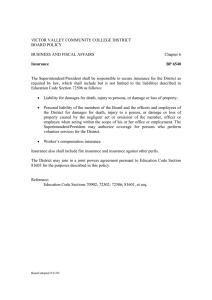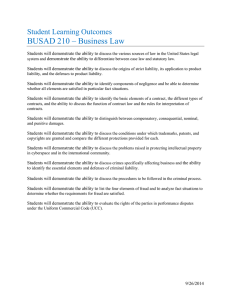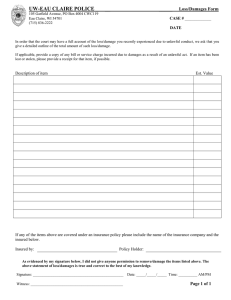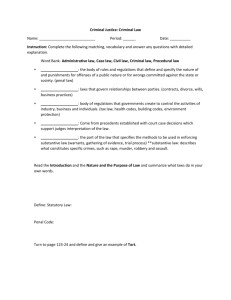Document
advertisement
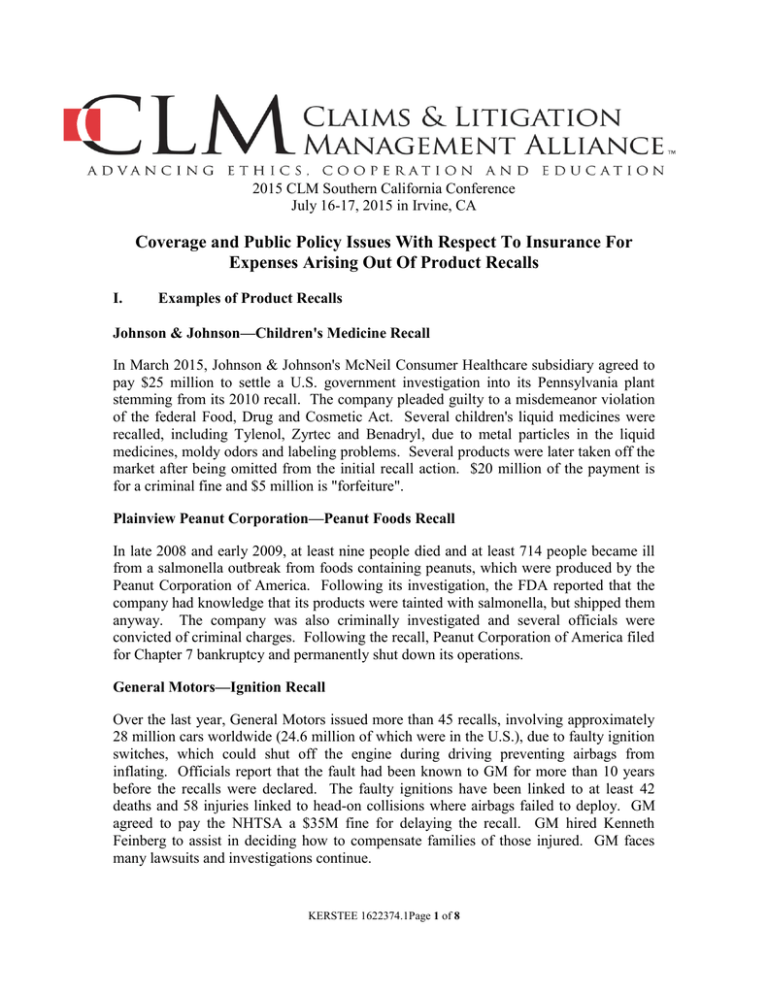
2015 CLM Southern California Conference July 16-17, 2015 in Irvine, CA Coverage and Public Policy Issues With Respect To Insurance For Expenses Arising Out Of Product Recalls I. Examples of Product Recalls Johnson & Johnson—Children's Medicine Recall In March 2015, Johnson & Johnson's McNeil Consumer Healthcare subsidiary agreed to pay $25 million to settle a U.S. government investigation into its Pennsylvania plant stemming from its 2010 recall. The company pleaded guilty to a misdemeanor violation of the federal Food, Drug and Cosmetic Act. Several children's liquid medicines were recalled, including Tylenol, Zyrtec and Benadryl, due to metal particles in the liquid medicines, moldy odors and labeling problems. Several products were later taken off the market after being omitted from the initial recall action. $20 million of the payment is for a criminal fine and $5 million is "forfeiture". Plainview Peanut Corporation—Peanut Foods Recall In late 2008 and early 2009, at least nine people died and at least 714 people became ill from a salmonella outbreak from foods containing peanuts, which were produced by the Peanut Corporation of America. Following its investigation, the FDA reported that the company had knowledge that its products were tainted with salmonella, but shipped them anyway. The company was also criminally investigated and several officials were convicted of criminal charges. Following the recall, Peanut Corporation of America filed for Chapter 7 bankruptcy and permanently shut down its operations. General Motors—Ignition Recall Over the last year, General Motors issued more than 45 recalls, involving approximately 28 million cars worldwide (24.6 million of which were in the U.S.), due to faulty ignition switches, which could shut off the engine during driving preventing airbags from inflating. Officials report that the fault had been known to GM for more than 10 years before the recalls were declared. The faulty ignitions have been linked to at least 42 deaths and 58 injuries linked to head-on collisions where airbags failed to deploy. GM agreed to pay the NHTSA a $35M fine for delaying the recall. GM hired Kenneth Feinberg to assist in deciding how to compensate families of those injured. GM faces many lawsuits and investigations continue. KERSTEE 1622374.1Page 1 of 8 Mattel, Inc.—Toy Recall In 2007, Mattel issued a recall of nearly one million toys in the United States because of lead paint dangers. The toys had been made by a contract manufacturer in China. The recall involved 83 different products, including Elmo, Barbie, Dora, Cars and Sesame Street toys. Mattel prevented many of the products from reaching consumers by stopping retailers from selling them, but more than 300,000 of the tainted toys had been sold to consumers. Mattel settled with the U.S. Consumer Product Safety Commission by paying a $2.3M civil fine to the violating the federal lead paint ban. The CPSC staff alleged that Mattel "knowingly" violated the federal law. Mattel also settled with the attorneys general of 39 states for $12M. Graco—Car Seat Recall After receiving more than 6,000 complaints of buckles that became stuck on car seats, Graco issued the largest child seat recall in the U.S.—eventually totally more than 6 million car seats. The National Highway Traffic Safety Administration is investigating whether Graco delayed its recall, which could subject the company to a $35M fine. II. Expenses Associated With Product Recalls Liability for Bodily Injury or Property Damage Product recalls may be associated with bodily injury or property damage of third parties. Alternatively, replacement parts may be issued without injuring persons or property. Fines and Penalties Following a product recall, companies issuing the recall often face criminal or civil fines and penalties for violating state or federal regulations, or for delaying the recall after having knowledge of the defect. Punitive Damages Companies that issue recalls may be subject to punitive damages. Depending on the state law, punitive damages may be based on statute or case law. Punitive damages are generally reserved for particularly egregious conduct, such as intent to harm. Reputational Damage Product recalls often damage a company's reputation and brand and hurt stock prices. Such reputational damage can be costly. KERSTEE 1622374.1Page 2 of 8 III. Coverage Issues – Coverage for Fines and Penalties Civil and Criminal Fines and Penalties Civil and criminal fines and penalties may be expressly excluded by the terms of the policy. Even in the absence of an express exclusion in the policy, in most jurisdictions, it is against public policy to indemnify an insured for civil and criminal fines and penalties. Courts in these jurisdictions have held that it would undermine the public policy behind the imposition of fines and penalties, which is to punish and deter. There is ample authority that insurance should not be made available to a person who has been punished or deterred by the imposition of civil fines or penalties. Policy Considerations - Definition of Damages A typical Commercial General Liability (CGL) coverage form does not define the term "damages". If the policy does contain a definition of "damages", look to see whether they must be compensatory in nature and whether "damages" includes punitive damages and civil fines and penalties. Even if there is no such express definition of “damages”, fines and penalties do not constitute damages because they are not compensatory in nature. See, e.g., Indiana Ins. Co v. Brown Packing Co., Inc., 2013 IL App. (1st) 113039-U (Ill. App. May 10, 2013) ($2 M civil forfeiture not “damages” because funds were product of illegal activity of injecting meat with hormones). Public Policy Issues In most jurisdictions, it is against public policy to indemnify insured for civil and criminal fines and penalties. See, e.g., Carney v. Coull Bldg. Inspections, Inc., 16 Misc. 3d 1114(A), 847 N.Y.S.2d 895 (Civ. Ct. 2007) (penalties that may be invoked for statutory violation are not covered under a standard policy issued by a liability insurance carrier); State Farm Fire & Cas. Co. v. Martinez, 26 Kan. App. 2d 869, 875, 995 P.2d 890, 895 (2000) (notwithstanding absence of specific policy language excluding coverage for civil penalties, it is contrary to Kansas public policy to insure against civil penalties arising out of insured's own actions); Blair v. Anik Liquors, 210 N.J. Super. 636, 510 A.2d 314 (N.J. Super. Ct. Law Div. 1986) (liability for penalties and sanctions for violations of laws cannot be protected by insurance). To allow coverage would undermine public policy behind fines and penalties—to punish and deter. See, e.g., Ulta Salon v. Travelers Property Casualty Company of Am., 2011 WL 2279527 (Cal. Ct. App. 2011) (award of civil penalties was not insurable "damages" because those penalties represented a "statutory punitive exaction determined on the basis of equitable principles, designed to deter misconduct and harm, not to compensate the plaintiff for actual damages sustained"). KERSTEE 1622374.1Page 3 of 8 Extension to Products Liability Context This is a State specific inquiry. Many States find that fines and penalties are uninsurable as a matter of public policy. See, e.g., Affiliated FM Ins. Co. v. Beatrice Foods Co., 645 F. Supp. 298, 305 (N.D. Ill. 1985) (punitive damages awarded against manufacturer of defective swimming pool coating were not recoverable from insurer as a matter of Illinois public policy, even though policy did not expressly exclude punitive damages, because coverage would undermine deterrent purpose of punitive award); Johnson & Johnson v. Aetna Casualty & Sur. Co., 285 N.J. Super. 575, 667 A.2d 1087 (App. Div. 1995) (punitive damage awards against plaintiff pharmaceutical company and its subsidiary in two failure–to–warn products liability cases were not covered by insurance as a matter of N.J. public policy, because affording coverage is against the underlying theory of punitive damages—to punish wrongdoer and deter aggravated misconduct in future, even if company is only vicariously liable); Ford Motor Co. v. Home Ins. Co., 116 Cal.App. 3d 374, 384 (Ct. App. 1981) (punitive damages awarded against Ford in underlying suit involving defective automotive products not insurable as a matter of California public policy, because the purpose of punitive damages is to punish and deter sufficiently culpable conduct); U.S. Fire Ins. Co. v. Goodyear Tire & Rubber Co., 920 F.2d 487, (8th Cir. 1991) (punitive damages arising out of products liability case against tire manufacturer not insurable under Minnesota public policy). IV. Coverage Issues – Coverage for Disgorgement and Restitution Disgorgement and Restitution Disgorgement or restitution may be expressly excluded by the terms of the policy. In any event, as a matter of public policy, most states will not allow insurance coverage for disgorgement of funds to which the insured was never entitled. Policy Considerations – definitions of "damages" or "loss" A typical CGL policy defines "damages" or "loss" such that disgorgement or restitution would not come within the definition. Check your policy's definition. Case law reinforces that claims for disgorgement and restitution are not claims for “damages” or “loss” within the meaning of an insurance policy. See, e.g., Level 3 Communications, Inc. v. Fed. Ins. Co., 272 F.3d 908, 910-11 (7th Cir. 2001), (“an insured incurs no loss within the meaning of the insurance contract by being compelled to return property that it had stolen, even if a more polite word than 'stolen' is used to characterize the claim for the property's return”); Reliance Group Holdings v. Nat'l Union Fire Ins. Co. of Pittsburgh, Pa., 188 A.D.2d 47,54-55, 594 N.Y.S.2d 20 (1st Dep't 1993)(insured did not sustain a "loss" within the terms of the insurance policy when it paid $21.1 million in partial restitution or disgorgement of greenmail). KERSTEE 1622374.1Page 4 of 8 Public Policy Issues Courts also find no coverage for disgorgement or restitution because it is against public policy to insure such payments. See, e.g., Vigilant Ins. Co. v. Bear Stearns Cos. Inc., 814 N.Y.S.2d 566, 2006 WL 118368, at *4 (Jan. 11, 2006) (“Disgorgement is a procedure designed both to deprive a party of ill-gotten gains and to deter improper conduct by making that conduct unprofitable. In general, a party may not recover disgorged funds through insurance because to do so would enable that party to retain the proceeds of its wrongful acts and shift the burden of the loss to its insurer. Such a result would also eliminate the party's incentive for obeying the law”); Bank of the West v. The Superior Court, Contra Costa County, 2 Cal. 4th 1254, 10 Cal. Rptr. 2d 538, 833 P.2d 545, 554-55 (Cal. 1992)(no insurance coverage for settlement of claims under Unfair Business Practices Act as a matter of public policy). Extension to Products Liability Context There is little case law concerning coverage for disgorgement and restitution in the products liability context. Like in other contexts, whether disgorgement and restitution is covered by the policy or insurable as a matter of public policy will depend on the specific terms of the contract and the public policy of the state. V. Coverage Issues – Coverage for Civil Liability Arising Out of Criminal Conduct Civil Liability Arising Out of Criminal Acts An insured who has been convicted of or pled guilty to a crime may subsequently face civil lawsuits brought by plaintiffs who suffered bodily injury or property damage arising out of the insured's crime. As a general rule, there is no coverage for civil claims arising out of criminal conduct where an essential element of the crime is intent or an expectation to cause bodily injury or property damage. Moreover, where the crime involves particularly egregious or intentional conduct, courts presume the resulting bodily injury or property damage was expected or intended. Policy language may specifically preclude coverage for such claims. Regardless of policy language, in general, it is contrary to public policy for an insurer to indemnify an insured for civil liability arising out of the commission of a criminal act where an element of the crime was to intentionally injure or destroy property. Policy Considerations Some policy definitions or exclusions may specifically exclude coverage for civil liability arising out of criminal conduct. Definition of Occurrence A typical CGL policy defines the term "occurrence" to mean "an accident, including continuous or repeated exposure to substantially the same general harmful conditions". KERSTEE 1622374.1Page 5 of 8 There is no coverage unless there has been an “occurrence”. See Alan D. Windt, 3 Insurance Claims and Disputes § 11:3 (6th ed.) (2014) (bodily injury or property damage that was the expected or intended result of the insured’s act is not considered damages caused by an occurrence). Exclusion for Criminal Acts A typical CGL policy does not contain a Criminal Acts exclusion (though criminal acts would likely be excluded by the CGL's definition of "occurrence" and/or the Expected or Intended Exclusion). In addition, some liability policies specifically exclude loss or damage caused by criminal acts. Case law confirms there is no coverage if policy contains a specific exclusion barring coverage for liability arising out of criminal acts committed at the direction of the insured. See, e.g., 20th Century Ins. Co. v. Schurtz, 92 Cal. App. 4th 1188, 112 Cal. Rptr. 2d 547 (2001) (because the policy contained an "intentional or criminal act" exclusion, the policy clearly excluded coverage for injuries resulting from a criminal act, whether or not the act was intentional). There is also no coverage where insured pleads guilty to intentional crime. See, e.g., Nancie D. v. New York Cent. Mut. Fire Ins. Co., 195 A.D.2d 535, 600 N.Y.S.2d 472 (2d Dep't 1993); N.N. v. Moraine Mut. Ins. Co., 153 Wis. 2d 84, 450 N.W.2d 445 (1990) (there was no coverage because "by his plea, [the insured] admitted committing a crime requiring intent to act"). Exclusion for Expected or Intended Injury A typical CGL policy excludes coverage for "Bodily injury" or "property damage" expected or intended from the standpoint of the insured. Case law confirms there is no coverage for expected or intended injury arising out of criminal conduct. See, e.g., Brooklyn Law Sch. v. Aetna Cas. & Sur. Co., 849 F.2d 788, 789 (2d Cir. 1988) ("New York courts interpreting the meaning of an 'occurrence' . . . have determined that liability coverage depends upon whether the alleged injury was intentionally caused or was an unintended, although foreseeable, result of the alleged intentional conduct"); Cont'l Cas. Co. v. Rapid-Am. Corp., 80 N.Y.2d 640, 649, 593 N.Y.S.2d 966, 970, 609 N.E.2d 506 (1993) ("[f]or an occurrence to be covered under the . . . policies, the injury must be unexpected and unintentional. . . . Resulting damage can be unintended even though the act leading to the damage was intentional"); Buckeye Union Ins. Co. v. New England Ins. Co., 1999-Ohio-67, 87 Ohio St. 3d 280, 283, 720 N.E.2d 495, 499 (1999) ("an intent to injure, not merely an intentional act, is a necessary element to uninsurability"). KERSTEE 1622374.1Page 6 of 8 Public Policy Issues It is against public policy to indemnify an insured for civil liability arising out of a criminal act where an element of the crime was intent to injure or destroy property. See, e.g., Fed. Ins. Co. v. Sandusky, 4:11-CV-02375, 2012 WL 1988971, at *4 (M.D. Pa. June 4, 2012) (Pennsylvania public policy bars indemnification of insureds for reprehensible, evil or illegal conduct); State Farm Fire & Cas. Co. v. Schwich, 749 N.W.2d 108, 115 (Minn. Ct. App. 2008) (insurance policies "are not intended to relieve an insured from the consequences of serious criminal acts, and we, as a matter of public policy, cannot condone coverage for such acts"); Chiquita Brands Int'l., Inc. v. Fed. Ins. Co., 2013-Ohio759 2013 WL 836861 (Ohio Ct. App. Mar. 6, 2013) (Ohio public policy generally prohibits insurance coverage for intentional acts). Extension to Products Liability Context Policy May Specifically Exclude - Exclusion for Recall Of Products, Work Or Impaired Property Because of a Known or Suspected Defect A typical CGL policy excludes coverage for Damages claimed for any loss, cost or expense incurred by you or others for the loss of use, withdrawal, recall, inspection, repair, replacement, adjustment, removal or disposal of: (1) "Your product"; (2) "Your work"; or (3) "Impaired property"; if such product, work, or property is withdrawn or recalled from the market or form use by any person or organization because of a known or suspected defect, deficiency, inadequacy or dangerous condition in it. Case law has specifically excluded coverage for civil liability arising out of criminal conduct. See, e.g., Compaq Computer Corp. v. St. Paul Fire and Marine Ins. Co., 2003 WL 22039551 (Minn. Ct. App. 2003) (underlying complaint alleged that Compaq intentionally sold computers that contained defective floppy disk controllers, causing the loss and corruption of user data in violation of the Computer Fraud and Abuse Act and coverage for Compaq's criminal act was excluded by policy’s exclusion for criminal, dishonest or fraudulent acts); McNeilab, Inc. v. North River Ins. Co., 645 F. Supp. 525, 550-52 (D.N.J. 1986) (drug manufacturer brought action against liability excess insurers to cover recall costs associated with tampering incidents involving its product and court found no coverage on public policy grounds because an insurer does not contract to indemnify an insured against the civil consequences of his own willful criminal conduct); Atlantic Mut. Ins. Co. v. Am. Academy of Orthopedic Surgeons, 315 Ill. App. 3d 552, 555-56 (Ill. App. Ct. 2000) (no coverage for defects in surgical screws inserted into patient's knees because conduct was deemed intentional and policy contained an KERSTEE 1622374.1Page 7 of 8 intentional acts exclusion); Industrial Sugars, Inc. v. Standard Accident Insurance Company, 338 F.2d 673, 676 (7th Cir. 1964) (sugar manufacturer's intentional failure to notify customer of contamination in sugar products not covered because it is not an “accident” within the meaning of the policy and would be against public policy). KERSTEE 1622374.1Page 8 of 8

